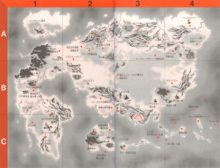Wanting to break from the Western influences common in his other series, when Akira Toriyama began work on Dragon Ball he decided to loosely model it on the classic Chinese novel Journey to the West.[6][7] He also redeveloped one of his earlier one shot manga series, Dragon Boy, which was initially serialized in Fresh Jump and released in a single tankōbon volume in 1983.[7] This short work combined the comedic style of Toriyama's successful six-year series Dr. Slump with a more action-oriented plot and paid homage to famous martial art actor Jackie Chan.[7][8] Toriyama notes that his goal for the series was to tell an "unconventional and contradictory" story.[9]
In the early concept of the series, Goku and Piccolo were from Earth. With the introduction of Kami, the idea of having fights from other planets was established and Goku and Piccolo were changed to alien species.[10] For the female characters, Toriyama felt it was not fun to draw "weak females" so he created women that he felt were not only "beautiful and sexy", but also "strong".[9] Going against the normal convention that the strongest characters should be the largest in terms of physical size, he designed many of Dragon Ball's most powerful characters with small statures, including the protagonist, Goku.[9]

The fighting techniques were initially unnamed, but the series editor felt it would be better to name them all. Toriyama proceeded to create names for all of the techniques, except for the Kamehameha (かめはめ波, lit. "Turtle Striking Wave") which his wife named when Toriyama was indecisive about what it should be called.[10] When creating the fictional world of the series, Toriyama decided to create basing it from his own imagination to avoid referencing popular culture. However the island where the World Martial Arts Tournament is held is modeled after Bali. When having fights in the manga, Toriyama had the characters go to a place where nobody lived to avoid difficulties in drawing destroyed buildings. In order to advance the story quickly, he also gave most fighters the ability to fly so they could travel to other parts of the world without inconvenience. This was also the reasoning behind Goku learning to teletransport (thus allowing characters to move to any planet in a second).[10]
After the first chapters were released, readers commented that Goku seemed rather plain, so his appearance was changed. New characters (such as Master Roshi and Krillin) were added and martial arts tournaments were included to give the manga a greater emphasis on fighting. Anticipating that readers would expect Goku to win the tournaments, Toriyama had him lose the first two while continuing his initial goal of having Goku be the champion and hero. After Cell's death, he intended for Gohan to replace Goku as the series protagonist, but then felt the character was not suited for the role and changed his mind.[12]
Toriyama based the Red Ribbon Army from a video game he had played named Spartan X in which enemies tended to appear very fast. After the second tournament concluded, Toriyama wanted to have a villain who would be a true "bad guy." After creating Piccolo as the new villain, he noted that it was one of the most interesting parts of the stories and that he, and his son, became one of the favorite characters of the series. With Goku established as the strongest fighter on Earth, Toriyama decided to increase the number of villains that came from outer space. Finding the escalating enemies to be a pain to work with feeling it was too simple, he created the Ginyu squad to add more balance to the series.[12] During this period of the series, Toriyama placed less emphasis on the series art work, simplifying the lines and sometimes making things "too square." He found himself having problems determining the colors for characters and sometimes ended up changing them unintentionally mid-story.[8] In later accounts, Toriyama noted that he didn't plan out the details of the story, resulting in strange occurrences and discrepancies later in the series.[13]